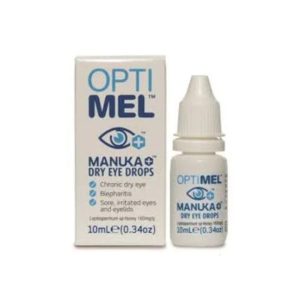Are you experiencing continuous dryness, irritation, or discomfort in your eyes? If the answer is yes, you may be among the numerous individuals suffering from a chronic dry eye condition that could be linked to Demodex mites. These minuscule, eight-legged creatures are naturally found within the human skin microbiome, particularly around the sensitive areas of the eyes and eyelids. However, when their numbers exceed normal limits, it can provoke inflammation and intensify the symptoms associated with dry eye syndrome, resulting in significant discomfort and distress.
If you have been dealing with unexplained dry eye issues for an extended period, it is crucial to explore whether Demodex mites could be a significant factor in your symptoms. In this comprehensive guide, we will help you identify the signs of a Demodex infestation, elaborate on the connection between these mites and dry eye disease, and present effective treatment strategies to manage their population and relieve your discomfort.

Recognizing the Distinct Symptoms of Demodex Blepharitis
Individuals affected by Demodex Blepharitis or an excessive population of these mites often encounter a range of specific symptoms that can significantly impact their quality of life. Common signs include:
- Burning, stinging, or gritty sensations in the eyes, especially noticeable as the day progresses.
- Unexplained excessive tearing or watery eyes that do not stem from allergies.
- Red, inflamed eyelids, along with irritation of the skin surrounding the eyes.
- Crusty, dandruff-like buildup along the lashes and lid margins, often appearing as collarettes.
- Extreme sensitivity to light, causing a constant urge to squint.
- Episodes of blurred vision that fluctuate throughout the day.
Many people endure these dry eye symptoms for years without realizing that an infestation of Demodex mites may be a critical underlying cause. Recognizing these symptoms is a vital step toward addressing the root issues effectively and improving overall eye health.

Exploring How Demodex Mites Lead to Dry Eye Symptoms
Wondering how these tiny creatures contribute to distressing dry eye symptoms? Demodex mites thrive on the oils and dead skin cells present on the skin, particularly within the hair follicles of your eyelashes. As they feed, they release waste products, eggs, and remnants of deceased mites, which accumulate along the lid margins. This buildup creates a substantial layer of debris and a bacterial biofilm that can obstruct the delicate oil glands essential for maintaining optimal eye health.
When these oil glands are unable to release an adequate amount of oil, it leads to the rapid formation of dry patches on the eye's surface. This oily tear film is crucial for preventing the quick evaporation of the watery tears that keep our eyes moist and comfortable. The inflammation triggered by this blockage can further intensify eye irritation, redness, and the uncomfortable gritty sensation often associated with dry eye conditions, making it essential to address the root cause effectively.
Gaining Insights Into the Life Cycle of Demodex Mites for Effective Treatment
Understanding the life cycle of Demodex mites is vital for implementing successful treatment strategies. These mites progress through several distinct stages: egg, larva, nymph, and adult, over a life cycle that typically lasts around 14 to 21 days. Notably, they are most active during the night, leaving their hair follicles to mate and deposit new eggs on the skin's surface.
This nocturnal behavior suggests that the optimal time to apply Demodex treatments is during the evening, just before bedtime. By targeting the mites when they are most active, you can significantly enhance the treatment's effectiveness. However, due to their rapid reproductive capabilities, any surviving mites can quickly repopulate, making ongoing treatment essential over several weeks or even months to achieve lasting results and improve eye health.
Effective Strategies for Managing Demodex-Related Dry Eye Symptoms
If your optometrist confirms a high count of Demodex mites through eyelash sampling or microscopic examination, they may recommend various treatment options to combat the infestation effectively:
1. Utilizing Tea Tree Oil Eyelid Wipes and Scrubs for Targeted Relief
Products containing tea tree oil are renowned for their powerful antimicrobial and antiparasitic properties, making them highly effective for eliminating mites. These formulations can remove surface mites, break down collarettes produced by these pests, and help draw out buried mites, making them more susceptible to treatment.
While tea tree oil is effective against mites, it can cause stinging upon application and may be cytotoxic to healthy cells, potentially exacerbating symptoms for some patients.
Regular application of tea tree oil eyelid wipes or scrubs before bedtime can gradually diminish the mite population. A notable example of a potent tea tree oil treatment is OcuSoft Oust Foam, which is particularly effective for managing blepharitis primarily caused by Demodex mites, providing a targeted solution for those affected.
2. Employing Gentle Hypochlorous Acid Lid Hygiene Sprays for Safe Eye Care
Hypochlorous acid is a naturally occurring substance produced by our immune system, serving as an effective antimicrobial agent. It is gentle on the eyes, does not cause stinging, and is safe for our cells.
Disinfecting lid sprays and cleansing foams containing hypochlorous acid not only eliminate mites but also help reduce inflammation and provide relief from uncomfortable symptoms. Applying these solutions to the lash lines before bedtime can effectively eradicate mites and their debris. Many of these products have a distinct odor reminiscent of chlorinated pool water. Popular hypochlorous acid-based solutions include Ocusoft Hypochlor Spray and Avenova.
Among these, Ocusoft Hypochlor Foam is frequently recommended due to its superior value and extended shelf life after opening, making it a practical choice for ongoing management of Demodex-related symptoms.
3. Discovering the Benefits of Manuka Honey Solutions for Eye Health
Recent studies suggest that Manuka Honey solutions may be as effective as 50% tea tree oil against Demodex, although further research is necessary in this area. While it may induce a slight sting upon application, Manuka Honey is generally less irritating than tea tree oil and exhibits remarkable efficacy against various forms of blepharitis. It is non-cytotoxic and less likely to provoke inflammation in the eyelids.
Numerous patients report that any initial sting is well worth it, as they often experience significant relief afterward. Manuka Honey solutions are available in gel form (such as Optimel Forte, which is more effective but may sting more) and as drops (like Optimel Drops, which are easier to apply and sting less), providing options for diverse personal preferences.
4. Addressing Severe Demodex Infestations with Oral Anti-Parasitic Medications
In cases where Demodex overpopulation is particularly severe and persistent, healthcare professionals may prescribe oral antiparasitic medications. For instance, formulations such as Ivermectin in pill form have shown effectiveness in managing these infestations. Furthermore, weekly doses of oral tea tree oil supplements taken over several months can help maintain mite populations at manageable levels and provide longer-lasting relief for those suffering from chronic dry eye symptoms.
5. Exploring Advanced Professional Treatments for Effective Demodex Management
Some eye clinics provide intensive in-office treatments specifically designed for Demodex management, utilizing specialized products such as Oust Demodex Cleanser Swabstix or a hand-held electric brush known as BlephEx.
The Oust Demodex Cleanser Swabstix offers targeted treatment options that can effectively assist in reducing the impact of these bothersome mites, delivering relief for patients struggling with persistent dry eye issues.
The Article: Demodex Mites Linked to Chronic Dry Eye Issues first appeared on https://writebuff.com.
The Article Demodex Mites and Their Connection to Chronic Dry Eye Was Found On https://limitsofstrategy.com





This post sheds light on a topic that is often overlooked yet deeply impactful for many individuals. Chronic dry eye syndrome can lead to persistent discomfort, and the connection to Demodex mites is particularly intriguing. I have personally encountered challenges with dry eyes, and it was only after several consultations that we finally considered environmental factors like these mites.
I’m really glad to see that this topic resonated with you. Chronic dry eye syndrome is one of those conditions that can slip under the radar. It’s easy to underestimate how much of an impact something like dry eyes can have on daily life—whether it’s affecting your work, your hobbies, or just your overall mood.
“Thanks for sharing your experience! If you’re interested in exploring more about how environmental factors like Demodex mites can affect dry eye syndrome, check out this insightful resource.”
https://arquiaca.org/VideoLeap
This topic resonates with me greatly, as I’ve been grappling with dry eye symptoms for a while now, and I never considered Demodex mites as a potential culprit. It’s fascinating how such tiny organisms, which we often don’t think about, can have such a significant impact on our health and comfort.
It’s interesting how our everyday experiences can lead us to uncover hidden factors influencing our health. Many people deal with dry eye symptoms for what seems like ages, not realizing that something as small as Demodex mites might be involved. It really makes you pause and consider how interconnected our body systems are, doesn’t it?